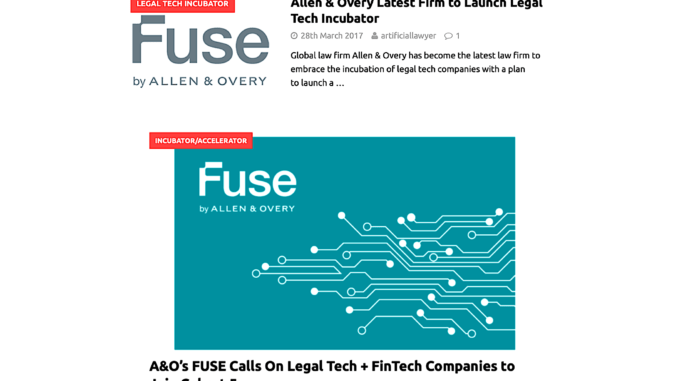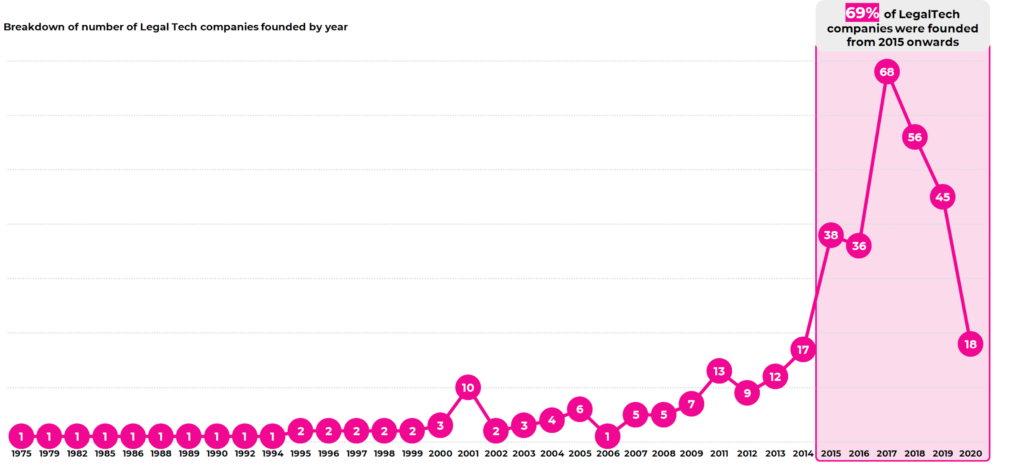
‘When we first did this, we didn’t know what would happen, or how long it would go on for. We were not even sure there would be enough companies to choose from each year,’ Allen & Overy’s Shruti Ajitsaria explained to Artificial Lawyer on the eve of the launch of Fuse’s latest cohort.
It seems hard to believe, but the global law firm’s Fuse programme is now into its fifth incarnation. Yet, as Ajitsaria noted, who is Head of the tech innovation space and incubator, when it started back in 2017 they were not certain at all about what was going to happen.
But, it has been a success and is now an important part of the firm. Over the years it has grown in size and also evolved, for example recent cohorts have included several fintech companies.
The fintechs, Ajitsaria explained, are there primarily so they can understand what their clients are doing and then better respond to those needs. I.e. cutting edge fintechs are focused on emerging trends and needs among banks and other financial institutions – A&O’s core client group, by bringing these startups into Fuse the lawyers at the firm can get great insights into one of their key client segments.
This is just one example of how a project that when it started was not guaranteed to go for more than one or two rounds has become an integral part of the firm, not just in terms of tech, but by increasing its market intelligence capabilities.

And, to the point about not knowing if there would be enough companies to include each year: there have been more than enough – and that is even when there are many more incubators and accelerators than before, from the pioneering MDR LAB, to Slaughter and May’s more recent Collaborate, to PwC’s scale-up accelerator, and others across Europe, Australia and the US.
In fact, as this site shows on a regular basis, there are always new companies coming to market with something to offer. There may have been a drop-off in total legal tech startups being created compared to the heady days of 2015 to 2017 (see table below), but many of the ones that are coming through now are high quality and have as much chance of success as some of the earlier pioneers. In fact, not being first movers may have helped some of them.

Fuse has also managed to navigate the pandemic by going virtual and this doesn’t seem to have impacted things, just the same as the rest of the legal world has carried on.
But, the bigger story is perhaps how Fuse is part of a widening vision around the use of tech at the firm that, to put it simply, goes far beyond the tech itself. This wider view also connects to areas such as the development of consulting services around legal ops for A&O’s clients, and a broader approach to legal data.
As Jonathan Brayne, a partner and Chairman of Fuse, told this site: ‘Many of our clients are not lawyers, they are transactional people. Fuse helps to make us relevant to those clients and we can then build on that.’
Meanwhile, the legal function consulting group, which is separate from Fuse, now has around 20 people. They might help a company’s inhouse team with ‘what KPIs and management information they should develop to demonstrate how the legal function adds value to the business and then how to collect data for the KPIs,’ Brayne said.
Brayne has also been involved with major surveys of clients around legal function innovation, and that has helped to inform the firm and allowed it to respond better to client needs.
Fuse is clearly not just a case of ‘let’s bring in a few startups, bung out a press release, and then do another one next year’. Fuse is part of a sustained push inside the firm to embrace tech and innovation that also stretches out to a deeper engagement with the clients. And what is learnt via Fuse also informs other initiatives across the firm.
In some ways it’s a virtuous circle, Fuse evolves and sparks the creation of new ideas and approaches, and evolving client needs drive changes in the companies A&O brings into Fuse.
And that then brings us back to the beginning: the startups, without which none of this would have happened.
Ajitsaria added that she is just as passionate about new tech companies as when she started.
‘One of the greatest sources of pride is when we choose companies that the lawyers really like to use,’ she said, and mentions how visual deal representation tool StructureFlow has proven to be a favourite among a number of lawyers at the firm. Drafting tool Define has also been well-received, she said.
‘Fuse has allowed us to have a finger on the pulse and to know what is coming through. Every year there is something I fall passionately in love with,’ she concluded.
Congrats to Ajitsaria and Brayne on the success of Fuse and its wider influence on the firm. Looking forward to seeing the next five cohorts!
1 Trackback / Pingback
Comments are closed.